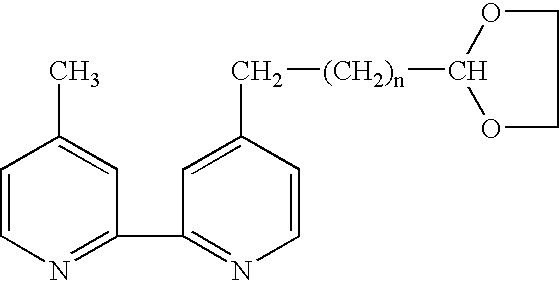Electrochemiluminescent assays
a technology of electrochemiluminescent assays and cytochrome c, which is applied in the field of electrochemiluminescent assays, can solve the problems of high cost, high cost, and high cost of radioactive labels, and achieves the effects of reducing the sensitivity of radioactive labels
- Summary
- Abstract
- Description
- Claims
- Application Information
AI Technical Summary
Problems solved by technology
Method used
Image
Examples
example 2
Sensitivity of Detection of Electrochemiluminescence of Ruthenium-Labeled Rabbit Anti-Mouse Immunoglobulin G (IgG) Antibody
[0159]The electrochemiluminescence of rabbit anti-mouse IgG antibody labeled with 4,4′-(dichloromethyl)-2,2′-bipyridyl, bis(2,2′-bipyridyl)ruthenium (II) (ruthenium-labeled rabbit anti-mouse IgG antibody) was measured in a 15 ml three-neck, round bottom flask containing 10 ml of a solution prepared as described below; a 1.5 mm×10 mm magnetic stir bar; a 1.0 mm diameter silver wire quasi-reference electrode; a combination 28 gauge platinum wire counter electrode, and a working electrode consisting of a 22 gauge platinum wire welded to a 1 cm×1 cm square piece of 0.1 mm thick, highly polished platinum foil. (The working platinum foil electrode was shaped into a {fraction (3 / 16)} of an inch diameter semi-circle surrounding the 28 gauge platinum wire counter electrode by {fraction (3 / 32)} of an inch equidistantly.)
[0160]The silver wire was connected to the EG&G Mode...
example 3
Immunological Reactivity of Ruthenium-Labeled Bovine Serum Albumin (BSA) in a Solid Phase Enzyme Linked-Immunosorbent Assay (ELISA)
[0166]The wells of a polystyrene microtiter plate were coated with a saturating concentration of either bovine serum albumin labeled with 4,4′-(dichloromethyl)-2,2′-bipyridyl, bis(2,2′-bipyridyl)ruthenium (II), i.e. ruthenium-labeled bovine serum albumin, (6 Ru / BSA, micrograms / ml in PBS buffer, 50 microliters / well) or unlabeled BSA (20 micrograms / ml in PBS buffer, 50 microliters / well) and incubated for one hour at room temperature. After this incubation period the plate was washed three times with PBS, 5 minutes per wash. A solution containing 6 mg / ml rabbit anti-BSA antibody was diluted 1:20,000, 1:30,000, 1:40,000, 1:50,000, and 1:60,000 in PBS, and the dilutions were added in duplicate to the wells coated with ruthenium-labeled BSA or unlabeled BSA, and the plate was incubated for one hour at room temperature. After three washes with PBS as before, th...
example 4
Immunological Reactivity of Ruthenium-Labeled Rabbit Anti-Mouse Immunoglobulin (IgG) Antibody by a Competitive Solid Phase Enzyme Linked-Immunosorbent Assay (ELISA)
[0169]Rabbit anti-mouse IgG antibody labeled with 4,4′-(dichloromethyl)-2,2′-bipyridyl, bis(2,2′-bipyridyl)ruthenium (II) (ruthenium-labeled rabbit anti-mouse IgG antibody) was compared with unlabeled rabbit anti-mouse IgG antibody with respect to its ability to compete with enzyme-labeled, anti-mouse IgG antibody for binding to mouse IgG. The wells of a 96-well polystyrene microtiter plate were coated with a solution of mouse IgG (5 micrograms / ml in PBS buffer), incubated for 60 minutes at room temperature and washed three times, 5 minutes per wash, with PBS. Two solutions were prepared, one containing a mixture of rabbit anti-mouse IgG-alkaline phosphatase conjugate and rabbit anti-mouse IgG (1 mg / ml), and the other a mixture of rabbit anti-mouse IgC-alkaline phosphatase conjugate and ruthenium-labeled rabbit anti-mouse...
PUM
| Property | Measurement | Unit |
|---|---|---|
| volume | aaaaa | aaaaa |
| pore diameter | aaaaa | aaaaa |
| volume | aaaaa | aaaaa |
Abstract
Description
Claims
Application Information
 Login to View More
Login to View More - R&D
- Intellectual Property
- Life Sciences
- Materials
- Tech Scout
- Unparalleled Data Quality
- Higher Quality Content
- 60% Fewer Hallucinations
Browse by: Latest US Patents, China's latest patents, Technical Efficacy Thesaurus, Application Domain, Technology Topic, Popular Technical Reports.
© 2025 PatSnap. All rights reserved.Legal|Privacy policy|Modern Slavery Act Transparency Statement|Sitemap|About US| Contact US: help@patsnap.com



